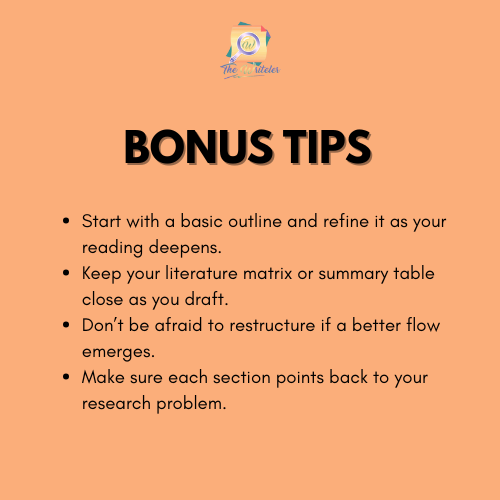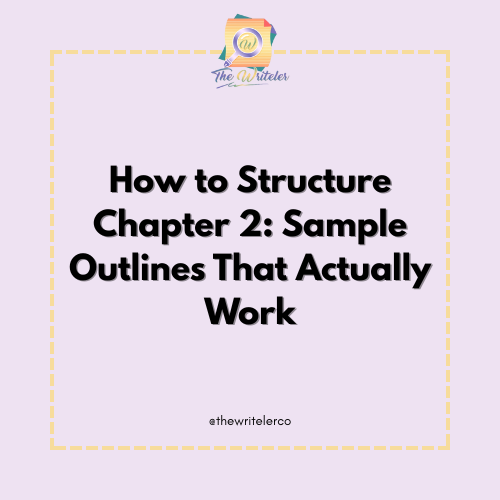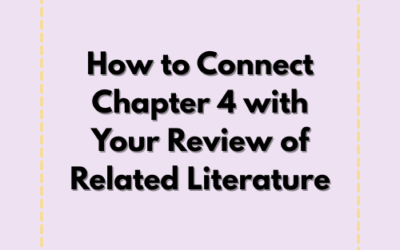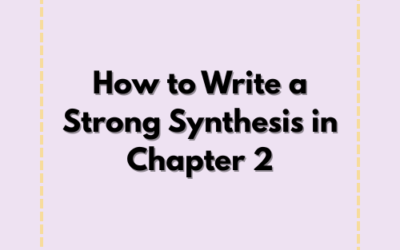Let’s be real — writing Chapter 2 (Review of Related Literature) can feel like you’re lost in an academic jungle.
You’ve read dozens of studies, highlighted paragraphs, and saved more PDFs than you can count. But now, you’re staring at a blank document wondering:
“How do I organize all of this?”
You’re not alone. One of the most common challenges in thesis writing is figuring out how to structure Chapter 2 in a way that’s logical, clear, and flows smoothly. The good news? There are proven formats that actually work — and we’ll walk you through them in this guide.
Why Structure Matters in Chapter 2
Your literature review isn’t just a reading log — it’s a critical part of your research that:
- Builds the foundation of your study
- Establishes your research gap
- Justifies your framework or approach
Without structure, your Chapter 2 can easily become a confusing list of summaries. With the right structure, it becomes a compelling story of what’s been done — and what still needs to be explored (by you).
Key Components of a Well-Structured Chapter 2
Whether you’re using a thematic, chronological, or framework-based approach, every Chapter 2 should include:
✅ 1. Introduction
A brief paragraph stating:
- What the chapter will cover
- How it’s organized (e.g., by theme or timeline)
- The importance of reviewing related literature
✅ 2. The Body
This is where you review and synthesize previous studies. Use headings and subheadings to guide your reader through major ideas, themes, or time periods.
✅ 3. Synthesis / Research Gap
At the end of your review, write a synthesis paragraph that:
- Summarizes the main findings
- Identifies gaps, inconsistencies, or underexplored areas
- Justifies your study’s relevance
✅ 4. Theoretical or Conceptual Framework (if required in Chapter 2)
Present the theory or model that underpins your study. Explain how it relates to the literature you’ve reviewed.
3 Sample Structures That Actually Work
📚 1. Thematic Structure (Most Recommended)
Group your review by major themes or variables in your study. Great for research with multiple variables or perspectives.
Sample Format:
- Introduction
- Theme 1: e.g., Mindfulness in Education
- Theme 2: e.g., Academic Performance Factors
- Theme 3: e.g., Mindfulness and Academic Outcomes
- Synthesis and Research Gap
- Theoretical/Conceptual Framework
✅ Why it works: Easy to follow, aligns well with research objectives, and is the most versatile format.
🕰️ 2. Chronological Structure
Organize your review based on time periods. Ideal for topics that have evolved significantly or if you’re highlighting trends and changes.
Sample Format:
- Introduction
- Studies from 2000–2010
- Studies from 2011–2020
- Recent Studies (2021–Present)
- Summary of Trends and Emerging Gaps
- Conceptual/Theoretical Framework
✅ Why it works: Highlights how thinking has evolved. Helps justify why your research is “next.”
🧩 3. Framework-Based Structure
Perfect for research grounded in a specific theory or model. Organize the review around the concepts or componentsof the framework.
Sample Format:
- Introduction
- Overview of Theory/Model (e.g., Maslow’s Hierarchy, TPB)
- Concept 1: e.g., Need for Belonging
- Concept 2: e.g., Self-Esteem Factors
- Concept 3: e.g., Achievement Motivation
- Literature Gap
- Presentation of Conceptual Framework
✅ Why it works: Strong alignment with theory. Great for thesis defense and conceptual clarity.
Real-Life Sample Outlines
🎓 Example: Education Thesis (Thematic)
Topic: The Effects of Mindfulness on Academic Performance among Senior High School Students
Outline:
- Introduction
- Mindfulness in Psychology and Education
- Academic Motivation and Performance Factors
- Mindfulness and Academic Outcomes: International and Local Studies
- Synthesis of Findings
- Conceptual Framework
💼 Example: Business Research (Framework-Based)
Topic: Customer Retention through Digital Loyalty Programs
Outline:
- Introduction
- Theoretical Foundation: Relationship Marketing Theory
- Customer Satisfaction in Digital Contexts
- Loyalty Programs and Consumer Behavior
- Research Gap and Implications
- Theoretical Framework
Tips to Choose the Right Structure
- Use thematic if your variables can be separated and discussed individually.
- Use chronological if your study builds on evolving trends or changing perspectives.
- Use framework-based if your study revolves around a core model or theory.
Also, ask your adviser or check your institution’s format guide — some schools have preferences.
Common Mistakes to Avoid
🚫 Mixing different structures randomly (e.g., jumping from theme to date to concept)
🚫 Not using headings and subheadings
🚫 Forgetting the synthesis and research gap
🚫 Including too many unrelated sections that confuse rather than clarify

Remember: structure isn’t about being “academic” — it’s about making your review easy to follow and hard to question.
📣 Need Help Structuring Your Chapter 2?
The Writeler Co. is here to support students and professionals who are juggling research with work, life, and business. Whether you’re writing a thesis, capstone, or dissertation for your master’s or Ph.D., we help you efficiently navigate the research journey — from brainstorming to proofreading.
📩 Message us today to get started.
📚 Let’s turn your research idea into a powerful paper.





0 Comments